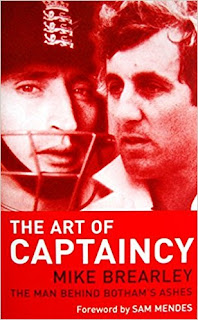Mike Brearley was a professional cricketer for around 20 years and was England captain for 31 of the 39 test matches that he played. His book, The Art of Captaincy, was recommended to managers by participants at both of the last couple of CEWTs, so it's been on my reading list for a while.
The book is, as you might expect, heavily biased towards the role of the cricket captain and some of the examples given in it require a bit of cricketing knowledge. Despite this, it has a lot to say to anyone with an interest in interpersonal relationships, particularly those in the workplace, particularly about manager-managee interactions. Here, I've collected and grouped a few of the passages that resonated with me.
Professionals should not rely only on practice during their day job
Compton was a genius and thus a law unto himself. But the general belief was then and continued to be that fitness for cricket was achieved simply by playing the game. (p. 54)
All cricketers can enhance their performance by better all-round fitness ... Injuries can be avoided, and an extra foot of speed, an extra inch of suppleness that avoid a narrow run-out or turns a half-chance into a chance can be achieved. (p.54-5)
Professionals, and those who advise, manage, train, lead, mentor, and encourage them, need to think carefully about the timing and context of learning
Most professional cricketers, myself included, have been unwilling to learn ... We distrust theory, and are apprehensive lest change bring catastrophe in its train. (p. 64)
If we define a good coach as "One who enables the potentialities of others to flower", Tiger Smith certainly qualifies: his advice helped me to my best season yet. It came from the right man ... at the right time ... The horse may not want to drink — or he may be unable to. (p. 68)
Excellent advice — but was this the moment for it? ... I felt that he should try to change at a less critical period in his career. The three of us talked this out throroughly. (p. 70)
Professionals recognise that there are different roles and responsibilities in their field, and that with them come different challenges
Gale's role in this process was typical of a good chairman of any committee. He had listened to the discussion, and was able to help the participants to see what it was that we were wanting. He did not, in this instance, need to be closely in touch with the facts on which our views were based in order to have this effect. (p. 84)
My own experience of vice-captaincy was in India, in 1976-7 ... I enjoyed the job, and was struck by how simple it is compared with being the man who has to act and "take the can". (p. 95)
In order to find all the evidence he needs a captain must watch the play. (p. 154)
The captain must be considerate, collaborative, and above all congruent
Some might argue that the captain should act like the junior officers in the First World War and never ask of another what he is not prepared to do himself ... However, such a policy may be simply silly. (p. 162)
The captain should expect the fielders to keep their positions, and not wander. He will demand that they are tidy in their work ... even when sloppiness does not cost runs. (p. 166)
I am often struck by the extent to which bowlers earn their attacking fields, and thus their wickets. Too often they deplore their bad luck when the edged shot misses the solitary slip; they forget that if they had bowled fewer half-volleys and long-hops they could have had a whole ring of slips. (p. 167)
... an important aspect of the captain's job: to remind, or even teach, bowlers that they have more resources than they give themselves credit for: they they have more strings to their bow. (p. 168)
... the captain should encourage all the team to think about the game from a tactical point of view; he must also insist that each member of his side plays a part in enouraging and motivating the others. (p. 170)
Bowlers expect their captain to give them a chance to perform at their best, be being aware of their capacities and preferences. They also have a right to a fair chance. The captain should avoid favouritism ... Yet true fairness is hard to assess. It is simply foolish not to give your best bowlers the first chance on a helpful pitch. (p. 172)
Certainly the captain can never please all his bowlers all the time. (p. 174)
... it was recognised that the captain is likely to get the best out of those he values highly. (p. 88)
The captain needs to maintain perspective
The captain's arc of attention will constantly oscillate between the short-term and other needs: between changes or schemes that concern the next ball or the next over, plans for the disposition of bowlers in the next hour ... or for the rest of the session, and indeed some outline of strategy for the whole day. (p. 182)
There was once a lionkeeper at the Dublin Zoo called Mr Flood, who was remarkable in that over the years he had bred many lion cubs but never lost one. When asked his secret he replied, "No two lions are alike." No doubt he had strategies and general lines of policy. But like a good cricket captain, he responded to each situation afresh. (p. 201)
Bob Paisley has said of managing Liverpool FC, "A manager has to cut his coat according to the cloth — he has to mould his team's style to the players available. The same applies to the individual player. None of them is perfect ... " The illusion of omnipotence is a particular trap for the captain with a well-developed sense of responsibility. (p. 273)Image: Amazon

Comments
Post a Comment